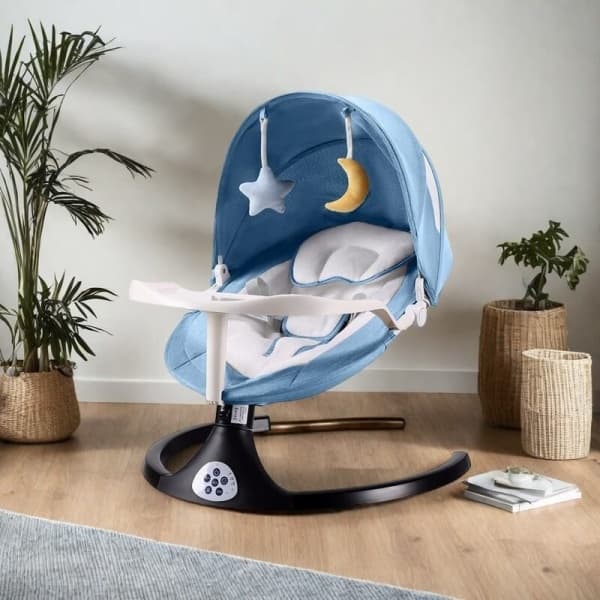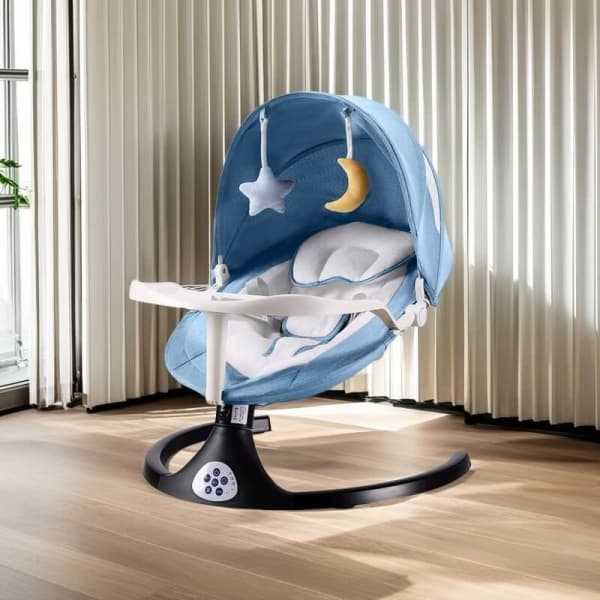Some parents rely on a swing or bouncer to help calm their infant during the first few months of life. Both of these mimic the rocking motion that your unborn child is accustomed to from the womb or from your arms.
Despite their apparent similarities, they have distinct features and advantages. So If you’re trying to decide which one to add to your registry this guide can help.
In this post, We will explore bouncers and swings to show you what they are, their benefits and drawbacks, and how to choose the one that could be best for your family.
What Is a Bouncer?

Baby Bouncer is a compact structure covered in soft, padded fabric to form a chair with springs or elastic that supports your child’s complete body. Where you can strap your baby in the chair and watch them play and bounce.
All baby bouncers function in the same way, regardless of features: the seat bounces up and down in response to your child’s movements, kicks, and wiggles.
Key Features of a Baby Bouncer
- Lightweight and portable design, Foldable frame
- Breathable textiles and mesh
- Simple, manual bouncing motion
Benefits of Using a Baby Bouncer
- No power outlets or batteries are needed, most can move depending on your baby’s movement or if the parent nudges.
- You can start using baby bouncers as soon as your baby is born, even if they are unable to hold their head or neck entirely.
- Your baby’s motor skills are stimulated by gentle, organic rocking.
- Simple to fold up, store, or transport on trips or excursions.
- The cloth seat is machine washable and simple to replace.
- Utterly silent because no motor is required.
Limitations of Baby Bouncers
- Bouncers are typically designed for newborns up to six months of age.
- 18 to 30 pounds is the usual weight limit for bouncers. The bouncer can topple over if your baby weighs more.
- Bounce seats can be a hindrance to crib training because your baby may easily become accustomed to falling asleep in such a gentle soothing motion. You should limit the use of a bounce seat to avoid teaching your baby to sleep in it all the time.
- For safety reasons, children cannot stay in the bouncer for long periods of time, only 15 to 20 minutes at a time.
- No automated movement; relies on baby or parent’s motion.
What Is a Baby Swing?

A baby swing is a seat that swings a baby, either manually or with the help of a motor. The seat may be adjusted in several positions and is fastened to a strong base.
Usually swinging back and forth, they simulate the soft rocking motion of a stroller or carriage. Typically, baby swings have several motions and speed adjustments. Additionally, swings offer your kid a mild kind of exercise that may be good for their growth.
Key Features of a Baby Swing
A baby swing has a broad, non-slip base and a strong frame. They also provide a plethora of other features, such as:
- White noise, calming music
- light
- Detachable toys
- Some have timer settings
- Bluetooth connectivity
- Rocking motions
Benefits of Using a Baby Swing
- Swings, as opposed to bouncers, give your infant continuous movement, which many babies find comforting.
- Generally speaking, they can be utilized from birth to 12 months.
- Babies who swing can better integrate and interpret sensory information, which is particularly beneficial for kids who have sensory sensitivity.
- Adjustable speed and motion options for baby comfort.
Limitations of Baby Swing
- Baby swings require a significant amount of setup area because to their robust frame.
- They are sometimes a little more challenging to set up than bouncers because of their size.
- Higher price range
- Not as easy to move between rooms or transport.
Difference Between a Bouncer and a Swing
A baby swing and a baby bouncer vary primarily in that the bouncer rocks naturally, whereas many baby swings are powered by electricity or batteries.
In a classic baby swing, your infant sits in a seat that is reclined and gently sways back and forth or side to side, in calming motions that can soothe a fussy baby or lull them to sleep.
A bouncer is a smaller seat that merely raises and lowers the infant, offering fun movements that can stimulate your child during playing.
Here are the more specific differences between the two:
| Feature | Baby Bouncer | Baby Swing |
| Design and Size | Lightweight and compact | Heavier and larger |
| Motion Type | Bouncing motion | Rocks back and forth or side to side |
| Age Suitability | Typically for younger infants from birth to six months old. | Can accommodate larger babies of up to 12 months. |
| Portability | Highly portable, easy to move and travel with. | Not as easy to move between rooms or transport |
| Space Requirements | Small footprint; great for limited space. | Larger footprint; takes up more space in the room. |
| Multifunctionality | Primarily essential for bouncing | Often includes more features like music and toys. |
| Comfort for Baby | Comfortable, but less supportive for long periods. | usually offer more plush seating and better support for longer use |
| Best for | Small spaces, short-term use, travel, or quick soothing. | Babies needing additional soothing or longer periods of use. |
Do I Need a Bouncer or a Swing?

The answer to this question ultimately boils down to personal preference, just like so many other pieces of baby gear. Swings and bouncers are both excellent ways to soothe fussy newborns. When used correctly and under supervision, these baby gears are safe and amazing.
Although they are not essential for every family, a swing and a bouncer may both be quite helpful. These gadgets give the infant a secure place to unwind, which can be invaluable for parents who need some alone time.
By keeping infants occupied, these gadgets can provide parents with much-needed respite. They give parents a variety of methods to calm their infants because rocking them with their hands for extended periods of time can be exhausting. This is especially helpful when the baby is being fussy.
By using these products, parents can have a few minutes of rare quiet time to restore their energy and avoid falling into excessive burnout. I believe that all parents are looking forward to this short but precious moment of leisure.
These baby products are lifesavers for parents who need to multi-task! Whether it’s cooking, answering emails, or tidying up the room, these baby products provide a safe and comfortable space for the baby so parents can focus on other tasks.
Factors to Consider When Choosing Between a Baby Bouncer and Swing
Sturdiness & Quality
In order to protect your infant from harm or falls, always inspect the model’s construction. Verify that the frame is extremely stable, robust, and long-lasting. To keep your infant comfortable for longer, pick a type with a higher maximum weight capacity.
A safety harness
To ensure your baby stays in position at all times, make sure the swing or bouncer you select has a safe, adjustable safety harness. A 5-point harness is ideal.
Head Support
Your baby won’t flop forward or sideways if you have a good head support that cradles their neck. This is important not just for comfort but also for injury prevention and the development of a healthy spine.
Power Source
Newborn swings and bouncers may or may not be battery-operated, as was previously noted. Make sure to carefully select the appropriate model based on your tastes and financial constraints. While some parents may want a model that moves on its own, others might be content with versions that need to be manually prodded.
Space Availability
Take into account the amount of space in your house. If it is a small size, a bouncer might be a better choice if space is at a premium. If you have more room a swing will be a good fit.
Budget
Swings are typically more expensive than bouncers. Establish your spending limit and assess which choice best suits your requirements.
Types and Number of motions
Knowing whether your swing or bouncer has one or several motions and speed settings is crucial to avoiding disappointment later. Your budget and personal preferences will determine this.
Age and Weight of the Baby
Verify the age and weight restrictions for both devices. A swing might be a better option if your infant is bigger.
Expert Tips for Using Baby Bouncers and Swings Safely

It’s crucial to utilize these baby gears cautiously despite all the advantages. Let’s examine some important pointers to remember when utilizing them.
- Place on Flat Surfaces: The bouncer or swing should always be used on a level, flat area to keep it from toppling over.
- Use Safety Harnesses: Ensure that the straps and harnesses on the swing or bouncer are tight and safely fastened.
- Don’t place objects in the gear: Never put cushions, blankets, or other soft objects in the swing or bouncer with your infant since they could suffocate them.
- Follow Weight and Age Limits: Only use the bouncer or swing until the ideal age or weight as recommended in the manufacturer’s instructions.
- Always Supervise: When your baby is in the swing or bouncer, keep a close eye on them.
- safety guidelines: Verify that the model you purchase complies with the guidelines established by the U.S. Consumer Product Safety Commission (CPSC) and the Juvenile Products Manufacturers Association (JPMA).
- Avoid Sleeping in Device: If your baby does fall asleep, move them right away to their crib, and don’t leave them there for too long. Leaving your infant in a swing or bouncer increases the risk of SIDS and flattens its still-soft skull.
- Inspect Regularly: check the bouncer or swing before using it, and stop using it right away if you see any damage.
Conclusion
The decision between swings and bouncers ultimately comes down to your baby’s preferences, your family’s needs, available space, and financial constraints. Before choosing, it’s critical to understand the differences between the two as each offers a distinct set of features and advantages.
If you are still unsure, It is always a good idea to check with your pediatrician or seasoned baby manufacturers like Clafbebe before making a purchase.
Recommended Related Articles:














